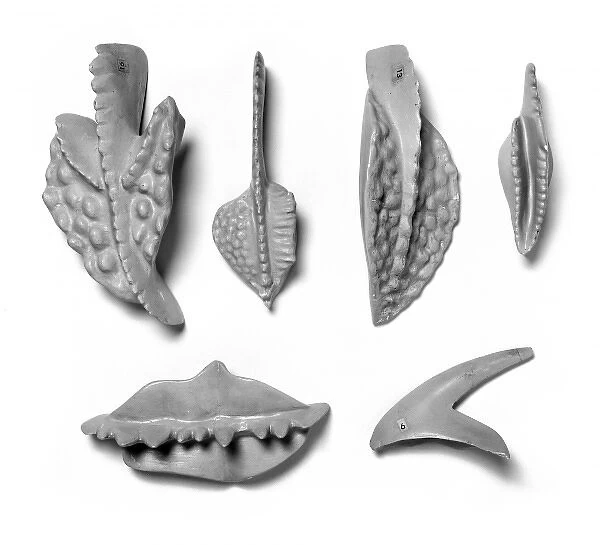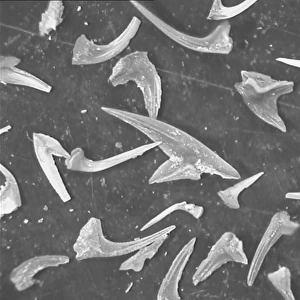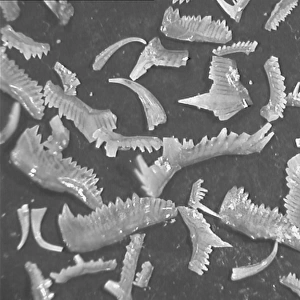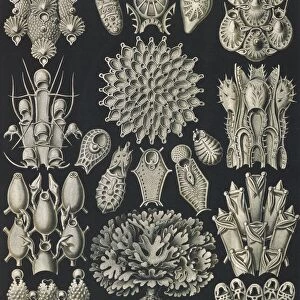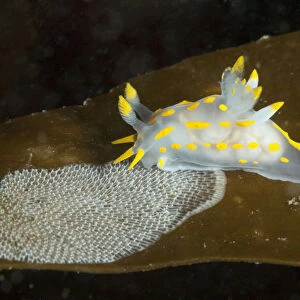Plaster models of conodonts
![]()

Wall Art and Photo Gifts from Mary Evans Picture Library
Plaster models of conodonts
From top left Ancyrodella, Gnathodus, Polygnathus, Cavusgnathus, Polygnathoides and Oistodus. These models were produced by Christain Hurfurth under the direction of Dr Klaus Muller
Mary Evans Picture Library makes available wonderful images created for people to enjoy over the centuries
Media ID 8612080
© Mary Evans Picture Library 2015 - https://copyrighthub.org/s0/hub1/creation/maryevans/MaryEvansPictureID/10712335
Bryozoa Bryozoan Creature Ectoprocta Fossil Fossilised Moss Animal Plaster Invertebrata
EDITORS COMMENTS
In this studio shot, a collection of intricately crafted plaster models of ancient marine invertebrates, known as conodonts, takes center stage. Each model, meticulously produced by Christian Hurfurth under the expert guidance of Dr. Klaus Müller, showcases the unique and diverse forms of these fascinating fossilized creatures. Conodonts, belonging to the phylum Conodonta, were small, eel-like organisms that lived during the Paleozoic Era, around 510 to 350 million years ago. These ancient marine inhabitants are classified as cyclostomes, a group of animals that includes modern-day lampreys and hagfish. However, conodonts are distinct from their modern counterparts, as they are extinct and possess several unique features. The top row of the models features Ancyrodella, Gnathodus, and Polygnathus. Ancyrodella, represented by the model on the far left, was characterized by its elongated body and a pair of large, fan-like appendages. Gnathodus, in the middle, had a more robust body shape and a distinctive, tooth-like structure. The third model, Polygnathus, displays a long, slender body with numerous small, tooth-like structures along its edges. The lower row includes Cavusgnathus, Polygnathoides, and Oistodus. Cavusgnathus, on the far left, is recognized by its flattened body and large, concave plates along its sides. Polygnathoides, in the middle, has a more elongated body shape with numerous small, tooth-like structures. The final model, Oistodus, on the right, displays a more complex structure with a large, flat head and numerous small, tooth-like structures along its body. These models, produced with exceptional attention to detail, serve as a testament to the rich diversity of life that once inhabited our planet's oceans. They provide valuable insights into the evolutionary history of marine life and offer a glimpse into the fascinating world of ancient organisms, the conodonts.
MADE IN THE USA
Safe Shipping with 30 Day Money Back Guarantee
FREE PERSONALISATION*
We are proud to offer a range of customisation features including Personalised Captions, Color Filters and Picture Zoom Tools
FREE COLORIZATION SERVICE
You can choose advanced AI Colorization for this picture at no extra charge!
SECURE PAYMENTS
We happily accept a wide range of payment options so you can pay for the things you need in the way that is most convenient for you
* Options may vary by product and licensing agreement. Zoomed Pictures can be adjusted in the Cart.

